Elizabeth Harrin's Blog
September 19, 2025
Executive Timeline Template: Present Your Project at a Glance

Sometimes a single slide is all you get.
When you need to present key milestones and progress to senior stakeholders, you don’t want to drown them in detail. You want a simple, clear, executive summary timeline.
This free template is designed for exactly that: a one-slide overview of major milestones and dates, perfect for reporting, board decks, or project reviews.
Download the Executive Timeline Template
Get the template (affiliate link)
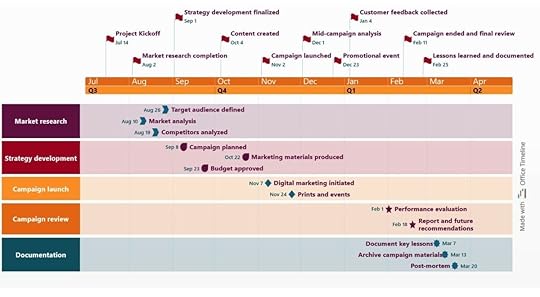 You can fully customise this slide and make it exactly what you needCan you really get away with one slide?
You can fully customise this slide and make it exactly what you needCan you really get away with one slide?Yes! And frankly, sometimes you have to.
As a project manager, the best-received exec presentation I did was the one where I didn’t actually use my deck. As I made my way to the front of the room, the CFO asked me to assume that everyone had read the slides (although I’m sure they hadn’t).
I was expecting that, so I skipped straight to the TL;DR and talked about the decision I needed.
Why use an executive timeline template instead of a full plan? Executives are busy, and usually don’t want to scroll through 40 slides. A summary timeline gives them:
A clear visual of major datesConfidence that the project is under controlA sense of progress at a glance.This is especially useful in:
Transformation programmesRegulatory projectsProjects where you have to show a stage-by-stage processClient-facing work where communication is key.I’m sure you can think of senior stakeholders where they would prefer a single executive roadmap graphic than a long written document.
Admittedly, some stakeholders will want the back up of a detailed plan or numbers, but start big picture and then focus in on the extra info – have that to hand in case it’s needed.
Is it within your job role to create an exec summary?Yes, it is within your job role to create an exec summary, because your ‘exec’ could be your line manager.
All you’re doing is presenting information in a summary slide format, using a template that you can reuse again when they ask for an updated version.
I think the summary timeline PowerPoint slide is a good one for anyone who needs to report upwards or outward. Especially if you are in the following buckets:
PMs reporting to leadershipProgramme managers creating board papersPMOs producing monthly summariesConsultants presenting to clients wanting to deliver a convincing pitch.Which covers quite a lot of roles. But don’t be limited by that. If you found this page because you want the template, then it’s right for you!
Personally, I find my presentation skills are magically improved when my slides are professional-looking with relevant content and visual cues to remind me of the key things to say.
When should you write an executive report summary?You should write an executive report summary when you’ve created a document that’s longer than three pages, that a busy person wouldn’t read.
When I create a steering deck, it includes an exec summary as the first slide (narrative text) then a plan on a page summary timeline.
When I write a business case or project update that is multiple slides, our process is to create a one-page summary document to go alongside it.
The goal of the exec summary is that it includes the bare bones info that senior management need in order to make a decision or to understand the key points. Then all the detail, explanation, rationale and so on goes in the main document, that they can read if they care enough.
They should be able to get all the key information they need from a summary.
What the template includesMS Office doesn’t have timeline templates built in, not ones that I would want to use anyway. Maybe it will in the future, but for now, the PowerPoint timeline I recommend is designed for busy stakeholders who just need the headlines.
Horizontal milestone layout (you can keep or remove the swimlanes)Space for major deliverablesTime markers by quarter or month (or both)Simple, clean slide layoutFully editable in PowerPointThis works well as the first timeline slide in a pack, or as a standalone summary for email or presentation.
How to use the templateDownload it hereUpdate the tasks, swimlanes and milestone text with key deliverables or decisionsAdjust the date range if needed (you can easily switch from quarters to months or keep both in)Change the colors to your brand colorsUse in status reports, steering packs or briefing decksIf you’re part of the 28% of project managers who use Excel for scheduling, then you can import your data to save you having to retype it.
It’s ideal when you don’t need a full Gantt chart, just the top-line story. But do remember to change the colors and fonts because unless these are your brand choices, they are not good!
Please note that this is a PowerPoint template so it won’t work in Google Slides. What you could do though is create your milestone chart in PowerPoint and export it, copy/paste it or save it as a picture with a screengrab and import it into your Google Slides presentation that way.
You can also screenshot it and paste it into Microsoft Word – I do that a lot when I need to show the overall project schedule in a Project Initiation Document, for example.
Bonus: Make it look even betterIf you’re short on time, this timeline for PowerPoint will help you show the essentials fast. Want to go one step further?
Use the Office Timeline plugin to create timelines like this one directly inside PowerPoint. You’ll save time and get consistent results, which is especially helpful for recurring reports.
You can set your brand colors too. And they are 100% editable.
This article first appeared on Rebel's Guide to Project Management and can be read here: Executive Timeline Template: Present Your Project at a Glance
September 1, 2025
The Best and Worst Email Habits for Project Managers

I don’t know about you, but we still rely heavily on email communication in project management. That, along with Teams messages, are the main ways we communicate.
I’m not alone, McKinsey reports that knowledge works spend 28% of the work week managing email. Microsoft’s research shows that users get 117 emails a day, most of them skimmed in under 60 seconds. Sounds like my lunchbreak.
Email is a vital tool for us all, but if you’ve ever come back from a week off and found your inbox full of 300 messages (most of which you don’t need to action), you’ll know how important it is for good email housekeeping.
Good email practice can streamline workflows – whereas the reverse causes confusion and frustration. With over 25 years of practice writing emails, I’ve got some good and bad email habits to share below so you can level up the way you interact with your team. These will keep teams aligned (or drive the bonkers if it doesn’t work effectively).
 The 5 best email habits (what works)
The 5 best email habits (what works)Let’s start with what works, what’s good email etiquette in project management (and in business overall). These are email productivity tips that work:
Clear and concise subject linesKeep emails brief and actionableUse CC and BCC properlySet clear action itemsUse templates for recurring messagesI love getting email messages from some colleagues as I know they will get to the point. Messages from other colleagues are… not quite as good. Let’s look at each of those points in turn below.
1. Use clear and concise subject linesA descriptive subject line improves email efficiency, because people can see from their inbox what they have to do.
Good subject lines:
FOR ACTION: Steering deck to reviewFOR INFO: Out of the office on FridayFOR APPROVAL: Decision on purchaseThese are clear and they summarise at the beginning what level of importance they carry.
Bad subject lines (these are real subject lines from my inbox, depersonalized!):
Fw: Systems (what is this about?)Project Name (there’s loads of comms on this project, what is this one specifically about)Meeting notes (what’s the meeting?)Take a look through your inbox and you’ll probably find more examples.
2. Keep emails brief and action-orientedEffective email communication at work means making it clear what you want. Long-winded emails dilute key messages because people scan information.
Use bullet points or put key information in bold so it’s called out when someone quickly scans through.
Read through your mails before you send them and try to take out words.
3. Use CC and BCC properlyUsing the ‘carbon copy’ and ‘blind carbon copy’ functionality properly is part of professional email best practice.
You’ve probably been CC’d into emails where you haven’t needed the info, although as a project manager I know from my own experience we often want (or need) to know what is going on. But cc’ing someone’s boss for the sake of it isn’t a good idea.
Use the CC field to copy the email to people who genuinely need to know.
If you want to drop people off the list, you can move them to BCC, so that when someone ‘replies all' (more on that later), they don’t get the rest of the chain. For example:
“Moving Claire and Elizabeth to BCC so the technical team can continue this – we’ll loop you into the decision.”
4. Set clear action items and deadlinesEffective email communication in teams means that every email should clearly define tasks and next steps.
For example: “Please submit your report by Friday, EOD” vs. “Let me know what you think.”
If you use your inbox as your To Do list like I do, this is really helpful!
5. Use templates for recurring emailsTemplates savetime and keep regular communication consistent so people know what to expect. For example, I have a standard weekly report email that I send out each Friday.
I take the last email from my Sent folder, edit the subject line and paste in the new content, and the structure says the same. The email addresses are then already populated (I have to remember to take Fw out of the subject line and update the subject line with today’s date.
You can template project updates, meeting follow-ups and other regular comms.
Get my template for a handover email to clients. I also have more email templates for handing over work to a colleague or writing a handover to your manager.
The 5 worst email habits (what to avoid)So if that’s what works, what do you need to look out for? According to data shared by the Financial Times, you and the people you work with are interrupted on average every two minutes by meetings, emails or notifications. So you really want to manage your time effectively.
Here are some common email mistakes to avoid.
1. Overloading inboxes with unnecessary emailsToo many emails lead to email fatigue and people missing important content. How many unread emails in your inbox?
My first top tip is to avoid sending too many emails for minor updates instead of using a project management tool, or collaboration tool like Teams or Slack. Inbox congestion just means things don’t get responded to.
Do this instead: Use the software you have to manage updates where you can so you keep short, chatty-type updates to a minimum. Add comments to the Google Doc you’re working on instead of pinging a list of comments over on email.
If you’re worried about emails landing when the person is out of the office, use schedule send. I do this to make sure emails arrive at a time I know the person is going to be at their desk.
2. Being vague or ambiguousKeep important stuff for emails, or things that you need to have documented for historical or audit purposes.
Unclear messaging leads to confusion and even more follow-up emails.
For example: “Can you handle this?” vs. “Please review the attached file and send feedback by Thursday.”
Do this instead: Be specific and clear, listing out the essential details. And if you can’t be, think about whether it’s worth sending the email at all.
Being able to communicate clearly is part of project management communication skills, so hopefully this one is not a stretch.
3. Reply-all abuse and unnecessary email chainsExcessive reply-alls clutter inboxes and frustrate teams, because it’s hard to know who the action is directed to.
The 5-email rule
When an email thread gets to 5 messages, take it off email and have a conversation about it. This is a tactic I talk about in my book, Managing Multiple Projects.
Do this instead: Use direct replies instead, to the relevant stakeholders. If you need to send a general update, do that once there is something concrete.
4. Ignoring tone and professionalismDon’t ignore tone of voice or professional email etiquette. Poorly worded or overly casual emails can lead to misunderstandings.
What this looks like in practice is:
Not sending an emoji back as a replySaying thank you in the body of the emailOpening and closing the email professionally “Hello/Dear…” and closing phrases like “Kind regards/Best regards” etc.Do this instead: Follow good email writing best practice. Re-read your emails before you send them. Set up a sending delay if you’re worried about firing off an email without doing the proper checks.
Check out my guide to project quality management, assurance and control to help with professionalism on the job.
5. Delaying responses or failing to acknowledge emailsDon’t delay sending a response (if you can help it). Long response times slow down project momentum and often the situation moves on before you get to the message.
However, I would strongly advise to balance that with not feeling like you have to check your emails all day every day. Multi-tasking is definitely not the best approach, so discuss as a team what acceptable email response times are. Schedule time for email responses.
Don’t forget to acknowledge the emails that need a response. If it’s something like ‘here’s the file you asked for’, you could send back a thank you message, but isn’t that simply sending an email for the sake of it? It’s clutter in their inbox.
Take direction from the culture of your team, I wouldn’t email back and I felt like there was a need for an acknowledgement, I would drop someone a message on Teams.
Do this instead: Acknowledge messages with a quick response emoji (Microsoft Outlook functionality).
If a message requires timebound action (“can you do this by end of day?”) then I would send a message back saying yes.
Quick team actions to implement nextHere are some quick actions you can work on with the team:
Set up team guidelines for email use – co-create email standards with everyone elseEncourage team members to audit their email habits and talk about what good practice looks likeCall out examples of good emails (I’d avoid highlighting bad examples in a team setting) to share what good looks like.You don’t have to do an inbox detox or get to inbox zero. You just have to have working practices that make sense and let your team get on to do their best work.
This article first appeared on Rebel's Guide to Project Management and can be read here: The Best and Worst Email Habits for Project Managers
July 2, 2025
How to Structure and Staff a PMO Without a Big Budget

Not every PMO starts with a team of full-time project professionals. Many small organizations begin with just one person wearing multiple hats.
Sound familiar? I’ve lost count of the number of times I’ve taken calls with project managers who are setting up a PMO for their department or team.
So it’s time to write out what I tell them! If you’re a small business owner, project lead or transformation manager trying to build a functioning PMO with minimal staff, shared resources, or part-time support, this is for you.
Read on for a guide to help you set up a structure that works now, but can grow later.
Pick the right PMO type for your realityBefore structuring your PMO, get clear on its role.
There are several types of PMO, but frankly you don’t have to stick to one of these. What you are aiming for is to determine the role you expect the PMO to play. Here are some examples.
Supportive PMOA supportive PMO offers templates, coaching, and best practices to the project leaders in the organization.
It’s a good approach for early-stage or resource-light businesses because you’re a centre of best practice.
Controlling PMOA controlling PMO adds structure and requires compliance from the projects in the team.
This works if leadership wants visibility and transparency, and you’ll be gathering data and reporting.
Directive PMOA directive PMO assigns and oversees project managers. It does resource assignments and capacity planning, and the project analysts and managers report into the PMO lead.
This is more common in mature organizations where you have consolidated the project resources under one leadership structure.

My advice would be to start with a supportive approach (with a bit of transparent reporting) and grow toward controlling as you prove value.
A PMO structure for small businesses is more likely to be a reporting and governance function in my experience, because what small businesses want is software, dashboards (or manually created reports, yikes) that show the impact of projects, value, investment, resource capacity and when new things can be started.
What roles do you actually need?Even with one person, you can structure work around functions:
PMO FunctionRole (Can be combined)Governance & PlanningPMO Lead / Ops ManagerReporting & DashboardsAnalyst / Admin / Automated ToolProject CoachingExperienced PM or part-time SMEAdmin & TemplatesAdmin support or VA (virtual assistant)You may only need 0.5 FTE total if you share across roles.
Document the project management office roles and responsibilities in a RACI matrix. I’ve put an example below – use this as a starting point but you’ll want to tailor it a little bit as necessary to fit your own organization structure.
PMO RACI MatrixFor more on how to use this kind of table, check out my guide to the RACI matrix.
PMO ActivityPMO Lead / Ops ManagerProject ManagerAnalyst / AdminSME / CoachDept Rep (PMO Ambassador)Define PMO Charter & ServicesRCACIMaintain project registerARCIDevelop reporting templatesACRIPortfolio reporting & dashboardsAIRIApprove new project intakeRCAIIProvide project coachingIRA/RRun project health checksAICRDocument governance processesRCACSchedule PMO meetingsCIRCommunicate PMO standardsRACCLegend
R = Responsible (does the work)A = Accountable (owns the outcome)C = Consulted (provides input)I = Informed (kept updated)Where should the PMO sit in the org chart?Your PMO’s impact often depends on where it reports.
Ops or Strategy Lead = Influence, but practical delivery supportFinance or CEO Office = Strategic, top-downIT = More delivery-focused, but risks being siloedChoose a reporting line that aligns with your PMO's goals (support vs control).
In my experience, you don’t really get to decide where the PMO sits. If you’ve been asked to set it up, then it is going to be in whatever area of the organization that you are.
It might move later, but right now as you get started, it’s sitting with you.
Borrow, don’t hire (yet)You need to come up with a PMO and staffing strategy, but that sounds a lot more fancy and hard work than it actually is. It’s about how you get the resources to fill the roles.
Let’s assume that in the first instance the person doing the PMO work is you. You’ll have to juggle the project manager vs PMO lead hats, but just think of it like being a fractional PMO.
Here are some ways to build capacity creatively.
Use fractional PMs: Bring in freelance or part-time project managers on big projects, to provide the governance and PMO support for a particular initiative.
Leverage internal champions: Upskill enthusiastic team members to be project leads (assuming you have some!)
Tap into virtual assistants: For status reporting, document prep, meeting scheduling – virtual assistants don’t have to work in the same company but you’ll need approval before you bring in external resource and they’ll need access to your systems.
Create “PMO Ambassadors”: Train 1 rep per department to act as liaison – useful for when you want to start spreading the word about expectations for management and governance of projects. Your outreach team then becomes your virtual PMO.
Think creatively: you don't need headcount, you need coverage.
Plan for growthEven the leanest PMOs need a growth path:
Track demand: number of projects, stakeholders supportedShow value: project outcomes, feedback, visibility improvementsBuild the business case: when reporting or delivery gets strained, expand.Basically, start wherever you need to start, and think a little bit about where you want to go next. As demand increases, you'll grow. It will just happen. It's better if it's planned and thoughtful, but don't stress about it at this point.
https://www.youtube.com/watch?v=KC8Xh... > Perfect!You don’t need to build a big machine. Start with functions, not job titles, and scale as demand grows.
You've got this!
This article first appeared on Rebel's Guide to Project Management and can be read here: How to Structure and Staff a PMO Without a Big Budget
June 30, 2025
Why strong working relationships matter more than you think
Back in 2008, Andy Crowe published research (in his book, Alpha Project Managers) that identified the top 2% of project managers – the high performers. What made them stand out? Among other things, they were excellent at building relationships.
These PMs weren’t just good at sticking to schedules or managing budgets. They had an exceptional ability to work across teams, tap into informal networks and influence beyond the org chart.
And that’s what made them more successful – or at least more perceived to be successful.
That research stuck with me. It’s something I reflect on often in my mentoring conversations. So in this article, I want to unpack the different ingredients that go into creating strong professional relationships, especially in the context of mentoring others.
Let’s take a look at what really makes a difference.
Set clear expectations earlyWhether you’re mentoring someone or managing a project team, expectations matter.
Without them, it’s hard to feel confident that you’ll get what you need – or know what’s expected of you. Setting expectations isn’t just about tasks and deadlines. It’s about trust, confidentiality, roles, and boundaries.
We have to meet the expectations on our side of the relationship to get the other person to demonstrate their side – show trust in order to receive it.

When I start mentoring someone, I always go over what we can (and can’t) share with their manager, the kinds of support I can offer, and how often we’ll meet. We treat it like a working agreement – one we can come back to and adjust as the relationship evolves.
The same applies on projects. For example, I recently helped a project manager set up governance for a new program. We walked through what our organisation expects from programme boards, clarified roles, and agreed how we’d work together day-to-day.
That half-hour conversation made all the difference: she knew where she stood, and we could go into stakeholder meetings aligned and confident.
That’s the magic of expectations – they eliminate surprises and boost clarity. Everyone knows what’s happening, and why.
Commitment isn’t about being available 24/7When people talk about commitment, they sometimes think it means working late or always saying yes.
It doesn’t.
In a professional working relationship, commitment looks like showing up when you said you would. Being present. Following through on the promises you make. That reliability builds trust – and without trust, a professional relationship doesn’t really go anywhere.
In my mentoring role, that means protecting the time I’ve committed to mentees. We’ve got regular monthly calls in the diary, and we stick to them. Sometimes we have to move things around, but the intention is always there: I’m here when you need me, and you’re a priority.
It’s the same with colleagues. People remember when you come through for them. And they also remember when you don’t.
Active listening is more powerful than it soundsYou’ve probably heard the phrase “active listening” before. But what does it look like in practice?
In The Coaching Manual (2021) Julie Starr says that active listening is important because it creates an environment where:
You set the intention to stay focused on the other person’s wordsYou use more effort to process and listen than on your own speechYou are investing effort in recording information mentally, so you can recall it again in future conversations (in addition to taking notes)You confirm you are still listening so the other person sees you paying attentionYou demonstrate your desire to understand through clarifying questions and summarizing so you get what the speaker is telling you.It’s not just nodding politely or pretending to pay attention while thinking about your to-do list. Active listening is about genuinely focusing on the other person. Asking clarifying questions. Summarizing what you’ve heard. Taking notes – not just for the sake of it, but so you remember.
It’s about making the other person feel heard.
In one meeting this week, I made a conscious effort to do just that. I summarized key points, clarified who someone was talking about by checking our org chart (without interrupting the flow), and reflected back what I’d heard to make sure we were aligned.
That’s active listening. And it made the meeting more productive for everyone.
Encouragement matters more than we thinkEncouragement doesn’t have to mean balloons and party poppers. It’s often the small things that have the biggest impact.
A timely “well done” on a job, a thank you email, a stretch opportunity that shows you believe someone can step up – these all matter. People want to know that their efforts are seen and valued.
The Management Centre says it is important to encourage people in the way they want to be encouraged. Personally, I’d rather a low-key encouragement; others might prefer a big fanfare or lots of ra-ra cheering which I would find cringe-worthy.
I had an email recently from someone who used to be in my mentoring group. She asked whether she should apply for a job at a company I know quite well. It wasn’t a perfect fit for her dream role, but I encouraged her to go for it – even just to learn more about the opportunity.
How to encourage othersDeborah Byrne, psychologist, says that encouragement is a great way to boost a relationship because it makes you a nice, positive, person to be around. Also, we can be an inspiration to others: by encouraging someone else, they can pay it forward and encourage others.
Byrne says our attitude matters because the way we are with others does influence their behaviour, even if it’s not obvious to you in which ways they are being influenced.
Byrne suggests that encouragement can be offered in different ways:
Being aware of how you speak about yourself and others, and avoiding negative language.Celebrating success and commenting when someone helps you (for example), and responding to their behaviour positively.Draw attention to what is going well for someone, for example pointing out their recent successes or what they’ve achieved.Smiling! (I feel I do a lot of smiling, so this is a way of encouraging others that I feel I can say I’m good at.)Other ways people can be encouraged include:
Specific ‘thank you’ messages related to specific tasks, given in a timely manner, either in a 1:1 setting or in front of others e.g. at a team meeting. This can be encouraging for future work as well as recognising past work.
Offering people stretch tasks and challenging work in line with their personal targets and objectives, along with the support to make sure these targets are achievable. This can show that you trust someone to take on more responsibility.
Support can be pivotal. Not in a cheerleader way (unless that’s your style), but in a grounded, “I’ve got your back” way. Realistic encouragement builds confidence and strengthens relationships.
Feedback: give it, take it, learn from itFeedback can feel awkward. But it’s one of the fastest ways to build trust and improve how we work with others.
I always try to give feedback that’s honest and constructive – especially in mentoring. Whether it’s reviewing a slide deck or talking through a tricky situation, I want my mentees to walk away with something useful.
At the same time, I’m open to feedback myself. If someone tells me I’m being too hands-off or they want more challenge, I take that seriously. Mentoring is a two-way street.
The key is delivering feedback with tact and clarity. Not everything needs to be actioned, but it should always be something the other person can hear – and act on if they choose to.
Understand what motivates peopleEncouragement is about recognising effort. Motivation is about understanding what drives it.
Are they driven by recognition? Career goals? The satisfaction of doing good work? When you understand what motivates someone, you can shape your interactions in ways that truly resonate.
Positive Psychology reports the Sheldon & Elliot self-concordance model of goal setting which outlines 4 different types of motivation:
External: You don’t take action unless there is a reward, or there is a negative outcome you are trying to avoid e.g. handing in work late.
Introjected: You take action because it helps maintain your self-image i.e. it feeds you ego to behave in a certain way.
Identified: You take action because the action is considered personally important or aligned to your values and therefore worth doing.
Intrinsic: You take action because the work required is fun i.e. you enjoy the journey towards achieving the goal.
Understanding motivation is important for relationship building, because if you understand what motivates someone, you can tailor the interactions to make sure you get the most out them, for example, by sharing information in a way that is tailored to the things you know will motivate them the most, whether that is career progression, a sense of being useful, achieving a goal etc.
For example, one of my mentees is clearly motivated by completing their apprenticeship and moving forward in their career. That helps me tailor the support I give and the opportunities I suggest.
I also took a leadership course years ago that showed I was motivated by financial rewards – that’s shifted over time, and today it’s more about professional reputation and doing a good job.
It’s worth reflecting on what drives you, too. Your motivation shapes how you show up in relationships.
And when the relationship isn’t working?Not every professional relationship will click. That’s OK.
But it’s important to address it. If I feel something’s off with a mentee, I’ll talk to them and try to uncover what’s going wrong. Are we aligned on goals? Am I offering support in the right way? Could they benefit more from a different mentor?
If we can’t get things back on track, I’ll suggest a change. There’s no shame in that. Sometimes relationships run their course – or just don’t land right – and it’s more respectful to acknowledge that than to keep going through the motions.
Relationships are everythingRelationships are everything in project management – and beyond. Whether you’re leading a team, mentoring a colleague, or navigating cross-functional work, your ability to build strong, respectful, trusting relationships will define your success.
It’s not about being best friends with everyone. It’s about being reliable, thoughtful, and genuinely invested in other people’s progress.
And that? That’s a skill worth developing.
This article first appeared on Rebel's Guide to Project Management and can be read here: Why strong working relationships matter more than you think
June 24, 2025
What Jobs Can You Get with the Google Digital Marketing Certificate in 2025?

The Google Digital Marketing certificate is one of the most popular of the Google Professional Certifications out there. I took the course in 2024 and earned the certificate.
While I’m not a full-time digital marketer, I run a blog and manage my own online presence as an author so I know the value of this certificate firsthand. So outside of my project management day job I do have a reason to brush up on digital marketing and e-commerce best practices.
I’ve spoken to some people about my experiences doing the courses and the question I get asked the most is: “Is the certificate enough to land a job?” In other words, is it worth it?
Key things to knowThe Google Digital Marketing & E-commerce certificate can help you get an entry-level job.Experience is also going to help you get a job, so figure out how to get some if you don’t have any already! (Ideas below) What the Google Digital Marketing Certificate covers
What the Google Digital Marketing Certificate coversThe certificate is made up of 7 courses. These are:
Foundations of digital marketing and e-commerceAttract and engage customers with digital marketingFrom likes to leads: interact with customers onlineThink outside the inbox: email marketingAssess for success: Marketing analytics and measurement (don’t miss this one!)Make the sale: Build, launch and manage e-commerce storesSatisfaction guaranteed: develop customer loyalty onlineYou don’t have to take them in order, but it makes sense to do so as they build as you go through.
You do have to take them all (and pass them all) to be awarded the certificate.
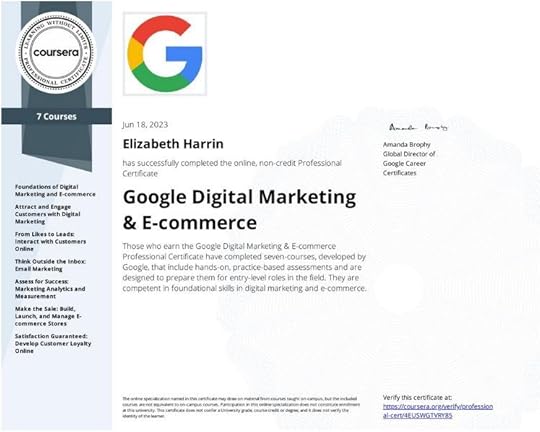 This is my Google Digital Marketing and e-Commerce certificateSkills covered
This is my Google Digital Marketing and e-Commerce certificateSkills coveredThere is a lot of focus on Google products like Google Ads (as you might expect) so that’s something to consider. If you particularly want to work with Facebook ads for example, then you might struggle at interview if you don’t have any direct experience of that.
You’ll learn topics like:
SEO & SEMEmail marketingGoogle AdsShopify basicsSocial media engagementIf those terms mean nothing to you, they are common jargon for employers so you’ve got to get your head around them. It's beginner-friendly training but practical.
These skills are going to equip you for digital marketing entry-level jobs.
Entry-level jobs you can apply forHere are some jobs you can go for, if you aren’t going to use the certificate as training for your side-hustle like I did.
Job TitleTypical Salary (UK/US)NotesDigital Marketing Assistant£22–30k / $40–55kGeneralist starter roleSocial Media Coordinator£25–35k / $45–60kFocus on content and engagementSEO/SEM Associate£28–38k / $50–70kStrong demand for analytical skillsEmail Marketing Assistant£26–34k / $45–65kCRM and campaign managementeCommerce Associate£25–32k / $45–60kShopify, product listingsThese are some of the best jobs after the Coursera certificate, but of course look for other relevant job titles and industries that appeal to your interests.
[lasso id="37249" link_id="301386" ref="google-digital-marketing-e-commerce"]Can you get a job with the Google Digital Marketing certificate?Yes. Many learners go on to entry-level roles like Digital Marketing Assistant, SEO Associate, or Email Marketer.
I personally didn’t try for this, but I know others have been successful and that Google partners actively seek out people who have taken this certificate.
However, if you want to work specificially with Facebook ads or Instagram influencers, you'd be better off with the Meta Social Media Marketing Professional Certificate.
Or do both, because then you'll have a rounded skill set to share with employers!
Both the Meta and Google certificates are available on a Coursera Plus subscription so if you have the time, you can work through them both in parallel. The faster you complete them, the less you pay.
How to boost your job readinessIf you're exploring Google Digital Marketing Certificate jobs, you'll find a variety of entry-level roles like Digital Marketing Assistant, SEO Associate, or eCommerce Coordinator that align perfectly with the skills taught in the program.
When you go for an interview, you’re going to want to be as ready as possible with a portfolio of evidence to talk about.
Here are some digital marketing job readiness tips!
Complete all the assignments, even if they’re not required (I didn’t do this because I wasn’t going for a digital marketing job)Build a sample campaign (blog, newsletter, social posts for yourself or a friend’s business)Use Canva, Mailchimp, Hubspot, etc. for real-life tools – many free options availableCreate a portfolio site (even on Notion or Wix) so you can share examples of your work.There’s also a new course in the professional certification which wasn’t available when I took the training: AI for your job search. It’s an optional course, so it won’t affect whether you earn the certificate or not, but it’s great for learning about how to use Gemini and Notebook LM to manage your job search, prep for interview, and polish your CV or resume.
Tips from employersI asked employers what they thought about how candidates can boost their employability and make their application stand out. Here are a few of the tips they shared.
"I pay more attention to them when the candidate effectively shows how they play a part in their overall career narrative, like if they took the course while also managing a specific project in a prior role, showing that they can apply the knowledge effectively in a real-world context," said Matt Erhard, Managing Partner at Summit Search Group in Canada.

Pair certificates with experience
Candidates who can demonstrate real experience leading teams and taking ownership of projects will always stand out the strongest.
Matt Erhard, Managing Partner, Summit Search Group
"For roles in digital marketing, the certificates are also making an impression," says Deepak Shukla, CEO of Pearl Lemon Placements. "Hiring managers are beginning to recognize these qualifications as evidence of job readiness, especially when paired with real-world project samples or freelance work."
He went on to add, "We often advise candidates to treat the certificates as a launchpad, not a guarantee, and to supplement them with measurable outcomes from any hands-on experience they can get."

Certificates are a launchpad
Recruiters do take note when these certificates are listed on LinkedIn, especially if they're paired with clear personal branding and relevant results.
Deepak Shukla, CEO of Pearl Lemon Placements
Read more about what employers have to say about Google Career Certificates and whether they open doors for job seekers: Employers weigh in: Are Google Certificates worth it to get a job?
LinkedIn and resume/CV tipsEmployers are going to check out your LinkedIn profile so make sure it shines!
Add your Credly badge so employers can verify your achievementUse keywords from the certificate in your headline and summary (like “Digital Marketing” and “Google-certified”)Post regular updates about your learning journey as posts or articles on LinkedInFollow companies in the Google Career Certificates employer consortium.That last point is important because the employer consortium companies actively hire Google ‘graduates’. Once you’ve completed the course, you get access to those resources and can find jobs from approved companies. It’s another job board to scour for openings!
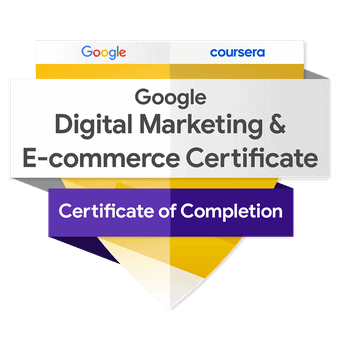 Google Digital Marketing Credly BadgeOther tools that help
Google Digital Marketing Credly BadgeOther tools that helpFinishing your certification is only the beginning. Here are some other things that will help you get that job.
Join communities. Check out r/marketing, LinkedIn groups, Slack channels and find your people. One of them might have job offers in the future.
Volunteer to run marketing for a small business or nonprofit. That could be your child’s school’s parent teacher organization – it doesn’t have to be a big commitment.
Keep learning. Watch YouTube videos, go to conferences, read newsletters, and follow content creators.
Keep practicing with the tools. Get proficient at using common tools like Canva and other image creators, AI tools, email marketing tools, and so on. Your future employer may not use those tools, but once you know how one email marketing product works, you can quickly figure out another.
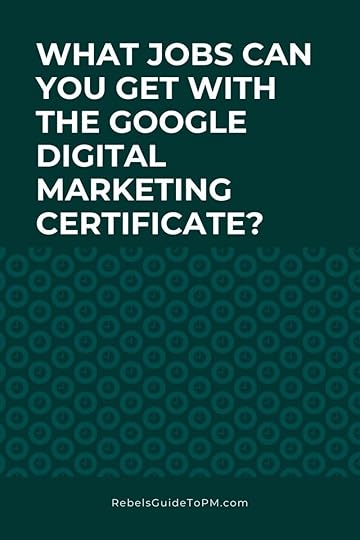 Your next steps
Your next stepsIn summary, yes, you can get a job with the certificate, but the certificate + experience is going to be your best bet for landing a well-paid entry-level post.
Keep learning, practicing, and applying your skills! You’re on the right track!
[lasso id="39905" link_id="302105" ref="google-professional-certificates"]This article first appeared on Rebel's Guide to Project Management and can be read here: What Jobs Can You Get with the Google Digital Marketing Certificate in 2025?
June 23, 2025
Google Project Management Certificate vs PMP: Which should you choose?

If you’re weighing up the Google Project Management Certificate against the Project Management Professional (PMP)®, you’re not alone. It’s a decision many aspiring and early-career project managers face.
I’ve done the Google Certificate and been a PMI member for years, working closely with PMP training companies for some of that time. So I’ve seen both, mentored new PMs, and led teams of experienced professionals. In this article, I’ll give you my take on what to expect from each one to help you decide which path is right for you.
Key things to knowThe Google Certificate and the PMP certification are for different stages of your project management career.Take the Google certificate if you’re a beginner or job switcher.Take the PMP if you’ve got 3-5 years of project experience.Both are great! Google Project Management Certificate vs PMP: A quick summary
Google Project Management Certificate vs PMP: A quick summaryLet’s see how the training and qualifications stack up.
FeatureGoogle CertificatePMP CertificationCost~£32/month via Coursera~£400–£500 exam fee + trainingTime to Complete1–6 monthsVaries; 35 hours of training requiredExperience NeededNone3–5 years of project experienceExam?No, graded assignmentsYes, 180-question examBest forBeginners, job switchersExperienced project professionalsFormatOnline, self-pacedExam-based, instructor-led or self-pacedRecognized byEntry-level employers, Google partnersGlobal employers, formal PM rolesThat table doesn’t answer what project management certification is best, but it will give you a quick reference guide so you can start making the right decision for you.
Read how the Google course compares to the IBM Project Management Certificate.
The Google Project Management Certificate – a quick overviewThe Google Project Management Certificate, delivered via Coursera, is designed for beginners.
You don’t need prior experience or a degree, and the content is structured to guide you from the absolute basics of project delivery to hands-on documentation in a final Capstone project.
You’ll learn:
Project lifecycle and methodologies (predictive and iterative/incremental aka Agile and waterfall)Stakeholder communication and soft skillsRisk, scheduling, planning and budgetingHow to draft project charters, plans, and reportsThe course includes video content, practice quizzes, real-world scenarios, and a comprehensive case study (I’ve written about how to get through the Sauce & Spoon case study in a previous article).
You’ll also receive a Credly badge to showcase your achievement.
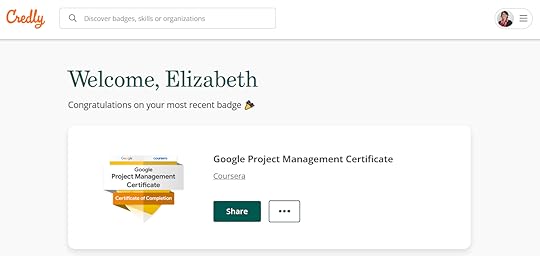 My Credly badge for the Google Project Management Certificate
My Credly badge for the Google Project Management CertificateYou can complete it in 1–2 months if you move quickly, but Google estimates a 6-month pace at 10 hours/week.
Read how I managed to complete the course in a week.
Want to get started today? Join the Google Project Management Certificate on Coursera and learn at your own pace.
PMP Certification – a quick overviewThe PMP® (Project Management Professional) is offered by PMI (Project Management Institute) and is considered the gold standard for experienced project managers by many employers and candidates (although as a UK-based PM, I would say that APM’s ChPP is the gold standard over here).
To qualify for the PMP, you must meet the following:
36 months of project leadership experience (with a degree)OR 60 months without a degree35 hours of formal PM education (the Google certificate can count toward this!)You’ll sit a 180-question exam covering all aspects of project management.
The PMP is globally recognized and often sought out for senior or mid-level PM roles in regulated industries, enterprise organisations, or public sector jobs.
[lasso id="19415" link_id="302096" ref="pm-prepcast"]Key differences between Google PM Certificate and PMP1. Experience levelGoogle Certificate: The best PM certification for career switchers, new graduates, or those wanting to explore PM. No experience needed.PMP: For established professionals who have led teams or projects. You have to be able to demonstrate your experience.2. AssessmentGoogle: Peer-reviewed assignments and quizzes (open book). The quality of peer reviews was hit and miss when I did it.PMP: Proctored, closed-book multiple-choice exam (with scenario-based questions). In other words, harder!3. CostGoogle: Subscription-based via Coursera, although you can pre-pay for the specialization if you prefer (~£32/month). The faster you finish, the cheaper it is (another reason why it’s the best project management certification for beginners).PMP: Exam fee ($405 for PMI members), plus cost of exam prep (~$500+ for a decent course).4. Time commitmentGoogle: Study at your own pace. Some finish in a few weeks, I did it in a week (probably not recommended, in hindsight)PMP: Requires prep time and a formal exam slot. Allow at least 3 months.5. Career outcomesGoogle: Helps you apply for entry-level roles like Project Coordinator, PM Assistant, or Junior Project Manager.PMP: Opens doors to senior PM roles and is often required in sectors like construction, IT, healthcare, and finance.Read my tips on how to get a job with the Google PM certificate.
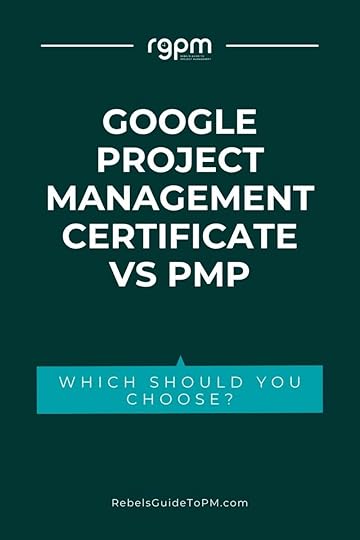 Which is harder: PMP or the Google Project Management Certificate?
Which is harder: PMP or the Google Project Management Certificate?‘Hard’ is subjective. When I took the Google certificate, I found it easy, but that’s because I already had 10+ years in project management at the time. As a beginner, you might find it harder as there are a lot of new concepts and business processes to learn.
However, I’d say that PMP is harder. There is more to learn, the assessment is more rigorous, the exam is punishing, and the standard is really high.
Don’t let that put you off – it’s a very worthwhile certificate!
Do employers recognize the Google PM courses or PMP?The Google Career Certificates Employer Consortium includes over 150 companies (like Deloitte, Accenture, and T-Mobile) who consider Google certificate graduates for open roles. The course is hosted on Coursera, one of the most widely recognized learning platforms.
Meanwhile, PMP is often required in job descriptions for mid-level or senior PM roles, especially in industries like defense, government, and construction.
However, in reality it's more nuanced than that. I've interviewed a number of executives about what employers think of the Google Career Certificates.
Gary Wallace, Managing Director of Greenline, a company that designs and delivers large-scale shade structures for schools, councils, and commercial spaces across Australia, summed it up.
"Whenever we hire, we’re looking for people who can actually run a site, communicate clearly with institutions and clients," he said. "A certificate doesn’t tell us how well a candidate can do that. It only tells us they have the knowledge."
He added:
"I think adding it to your resume and briefly bringing it up in the interview is fine. But it should be secondary to showcasing actual project work. Anyone who’s hiring for this role wants to see the kind of projects completed. Certificates alone don’t paint a very detailed picture, and they never will."

Certificates are helpful
Certificates are a helpful resource, but they’re better if you're just starting out or switching careers. If you’re new to the field, it’ll help you get up to speed on the basics. But there are so many ways you have to prove you can apply that knowledge. Even if it’s unpaid or volunteer work, first focus on that and then use the certificate as a complement to build your track record.
Gerry Wallace, Managing Director, Greenline
It’s actually a very simple choice.
For beginners? Google certificate.For experienced PMs? PMP.For career switchers? Start with Google, then aim for PMP.Choose Google if...Choose PMP if...You’re new to project managementYou already lead projectsYou want to build foundational skillsYou need global recognitionYou’re looking for a flexible, affordable courseYou’re aiming for senior PM rolesYou want a practical, low-barrier introductionYou’re eligible and want a salary boostStill unsure? Many project managers start with the Google Certificate and later pursue the PMP (or another certificate like ChPP or an industry-specific one) once they have the experience.
It doesn’t have to be either/or, it’s a progression as you build your career.
Your next stepsThere is really no right or wrong answer – both courses are good. I took the Google certificate late in my project management career (because it wasn’t available when I started). If it had been available earlier, I would have taken it earlier as it’s a very solid course for beginners.
The key is to choose what’s right for your career stage and goals.
[lasso id="35054" link_id="302097" ref="coursera-pm"]This article first appeared on Rebel's Guide to Project Management and can be read here: Google Project Management Certificate vs PMP: Which should you choose?
June 19, 2025
Google vs Meta Marketing Certificates: Which Should You Choose?

Are you trying to decide between the Google Digital Marketing Certificate and the Meta Social Media Marketing Certificate on Coursera? You’re not alone. Both programs are highly rated, beginner-friendly, and taught by two of the biggest names in the tech and advertising world.
I’ve completed the Google certificate myself (you can read my full review here) and found it a solid foundation in e-commerce, SEO, email marketing, and analytics.
While I haven’t taken the Meta course yet, I’ve reviewed its syllabus, explored feedback from other learners, and compared the structure, tools, and job fit side by side.
In this article, I’ll walk you through:
The key differences between the Google and Meta marketing certificatesWho each one is best forCareer outcomes and hiring prospectsWhether it’s worth doing bothLet’s dive in and help you choose the certification that fits your goals—and lands you the job you want.
 Overview of both certificates
Overview of both certificatesLet’s do a quick recap of what these courses from marketing giants cover.
FeatureGoogle Digital MarketingMeta Social Media MarketingDuration~6 months~6 monthsCost£32/mo (Coursera)£32/mo (Coursera)Number of Courses86Capstone ProjectNoYesFocusSEO, email, analytics, e-commerceFacebook/IG ads, content creation, social strategyTools CoveredGoogle Ads, Google Analytics, Shopify, Hubspot and othersFacebook Business Suite, Canva, InstagramThey are both available on Coursera and are included with Coursera Plus (so if you have a subscription, you could take them both).
Is the Google or Meta marketing certificate easier?I’d say the Google one is easier to complete because it does not include a Capstone. Course 8 (the AI job search course) is optional. There are several optional assignments.
So, if you’re looking for an easy ride, the Google certificate is certainly do-able.
However, if you want to get a job and do well in your new career, I don’t think you should be looking for easy! Do all the assignments. Practice using the tools. Don’t shy away from the Capstone because it takes a while – it will make you a better marketer!
There is a learning curve with both certificates, which is about the same.
Who is the Google Certificate best for?The content of the courses determines the fit for students. The Google course is e-commerce and business focused, suitable for people who are looking to work in traditional businesses.
I’d say it was best for:
Aspiring digital marketers looking for broad knowledgeBusiness owners or freelancers who want e-commerce and analyticsPeople interested in SEO/PPC/Google Ads roles – this is a very specialized skill!I did this course (and passed, yey!) and I don’t do digital marketing for a traditional business, but it taught me about e-commerce, CPC and other things that are helpful in my work on website development projects in my day job.
This course also has a job search module, Accelerate your job search with AI, which is helpful, especially if you don’t know where to start! It will help you polish your CV or resume, LinkedIn profile and prep for interviews.
Want to know what roles you can get with this qualification? Read my full guide about Google Digital Marketing Certificate jobs.
[lasso id="37249" link_id="301368" ref="google-digital-marketing-e-commerce"]Who is the Meta Certificate best for?Meta’s course won’t teach you anything about Google Ads (obvs) so it’s more relevant for people who are supporting social media within their business. For example:
Those aiming for social media-focused rolesCreators, influencers, or small business owners building on IG/FacebookPeople who want to work in community management or paid social.The big benefit is that you get the Professional Certificate (which is ACE® recommended for prior learning) but you also get the Meta Digital Marketing Association Certification.
Once you have taken this course, look for job titles like:
Social Media ManagerSocial Media SpecialistSocial Media Coordinator… it’s all very social media-y.
Want to learn more about Meta’s course? Explore it on Coursera.
[lasso id="39951" link_id="302076" ref="meta-social-media-marketing-professional-certificate"]CertificateTarget Job TitlesBest ForGoogleDigital Marketing Assistant, SEO Associate, Email Marketing CoordinatorGeneralist, e-commerce, analyticsMetaSocial Media Manager, Content Creator, Facebook Ads SpecialistCreators, social-first marketers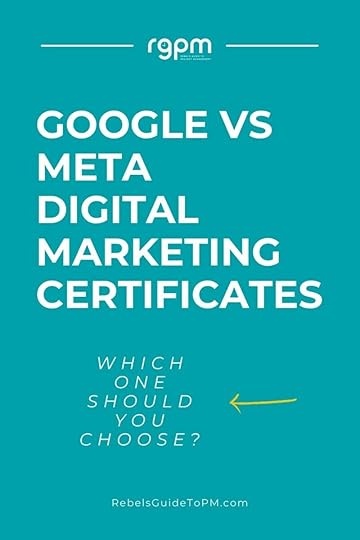 Which has better career outcomes?
Which has better career outcomes?Google’s course aligns better with job listings for SEO, marketing assistants, etc.
Meta’s course suits freelancers, people working in the creator economy, and content management roles – perhaps I should have taken this one after all!
Read next: What employers think hiring candidates with Google Certificates - read the interviews!
In terms of are you likely to get a job having taken one of these training programs, Google’s Employer Consortium is a win for me. That’s a group of Google partners who actively recruit from ‘graduates’ from their certificates. You’ll get access to their job seeking resources once you’ve completed the course.

A strong supplemental credential
We’ve interviewed and hired candidates who listed Google Professional Certificates, particularly in Digital Marketing and Project Management. While the certificate alone is not enough to guarantee a hire, it signals that the candidate has taken initiative and completed focused, relevant training. It often helps them stand out in a crowded applicant pool, especially when they lack formal experience.
Jared Bauman, CEO, 201 Creative, LLC
However, the Meta program ends with a Capstone, which means you’ll get a tangible project you can use to show employers what you can do. Meta’s training is excellent and you’ll be learning first hand from the people behind Facebook and Instagram – that’s worth a lot.
There aren’t any published stats that I could find about which certificate has the best employability outcomes, but they are both well-respected.
 This is my Google Digital Marketing and e-Commerce certificateMy recommendation
This is my Google Digital Marketing and e-Commerce certificateMy recommendationWhile you have to make the final choice yourself, this is my take on it:
For generalist marketers or career switchers --> GoogleFor content creators or social media specialists --> MetaHaving said that, you could do both, or start with one and supplement with the other. Whichever you choose, good luck with your learning!
This article first appeared on Rebel's Guide to Project Management and can be read here: Google vs Meta Marketing Certificates: Which Should You Choose?
June 17, 2025
The First 30 Days of Your PMO: A Week-by-Week Setup Guide for Small Teams

Have you been asked to “set up a Project Management Office” but you aren’t really sure where to start? I know the feeling!
I’m going to share with you a step-by-step plan for setting up a PMO. These simple steps are specifically aimed at smaller teams, so if you are a project manager who has been asked to stand up a PMO function, or an operational leader, a program manager, or anyone else who now has responsibility for tracking projects across the function or organization, this is for you.
For the bigger picture view, check out our 12-step PMO set up checklist which goes through the core components of building a PMO.
Your 30 day planLet’s not kid ourselves: setting up a PMO takes time and commitment. I’ve laid out the steps to do in the first 30 days so you can get started, but it could take longer if you need to overcome some office politics.
The overall process for a lightweight project management office is:
Understand the landscape and draft a planDefine the PMO Charter and start engagementBuild core processes and toolsPilot, refine and communicate.The actual time it takes is going to depend on your team set up, the commitment from your senior management and leadership team and how much time you’ve got to dedicate to your PMO creation.
A note on methodologiesI was contacted recently by a reader who wanted to know what was the best methodology for her team.
There is no ‘right’ answer to this, especially if you are setting up a PMO in a small business.
Project management methodologies are the ‘how’ you do your projects and in my experience they are mostly in-house. Even if you start out with a tailorable method like PRINCE2, the way it’s adapted and implemented in-house makes it into ‘your’ methodology.
I don’t think it really matters, as long as project execution is happening, relevant stakeholders are engaged, project status is reported and there is a degree of control with adequate governance.
Yes, you can adapt a published methodology. You can train your team in a particular approach, but you still have to allow individuals a degree of freedom for delivery, especially for complex projects where you don’t want your governance to become a box ticking exercise.
Aim to set project management standards, provide some project checklists of expected good practice and you’ll be a long way towards helping project managers deliver effectively.
Week 1: Understand the landscape and draft a planGoal this week: Understand the business context, identify pain points, and sketch the PMO’s purpose.
What to do this weekMeet key stakeholders: Talk to exec sponsors, department heads, project managers.Audit existing projects: Get a list of current and recent projectsIdentify pain points: What's going wrong? Missed deadlines, no visibility, no strategic alignment, resource clashes?Sketch the initial PMO model: Supportive, controlling, directive? What model do you want to be? (This will be based on org maturity.)Start a PMO Setup Plan: Define your goals for the first 90 days.Set stakeholder expectations: Clarify what the PMO will and won’t do.What you’re trying to achieve this week is to work out where to start from. The pain points will help you assess where standard governance or templates would create some quick wins.
In my experience, that’s often project onboarding and/or project closure. For example, in one organization I know, execs said yes to every project and then wondered why teams were drowning in work and not completing anything… Hmm, I wonder why?!
Fixing the onboarding and project requests process meant decisions were made with more information and with better prioritization, so teams could manage the flow of incoming work more effectively.
If that rings a bell with you, perhaps looking at project approvals and initiation, and project portfolio governance, is a good place to start for your teams too.
 Assets to create at this pointStakeholder analysis, stakeholder map and stakeholder engagement planIssues/pain points logPMO vision draftPMO implementation plan (so you know where you're going!)
Assets to create at this pointStakeholder analysis, stakeholder map and stakeholder engagement planIssues/pain points logPMO vision draftPMO implementation plan (so you know where you're going!)These don’t have to be final versions. You can evolve these documents as you go, but at least now you have as starting point.
The vision information is likely to come from the person who asked you to set up the PMO. They’ll have an idea about what they want to achieve.
It could be transparency across all projects, better reporting, oversight, resource management, an approach to dealing with project issues, mentoring and support for project managers, applying standard methodologies or something else. Talk to your manager or key exec leader and find out what they think the PMO is going to do for them.
Week 2: Define the PMO Charter and start engagementGoal this week: Get alignment and buy-in for the PMO's mission, scope, and authority.
What to do this weekWrite a lightweight PMO CharterPurposeObjectivesServices offered (e.g. reporting, templates, coaching)Governance modelPresent your draft to stakeholders: Collect feedback and iterateStart brand building: Pick a name, define tone/ethos (e.g. “Project Support Office” vs “Portfolio Office”)Agree reporting lines: Who owns the PMO and who supports it?This week, you’re working to review what you’ve learned so far with the senior managers who will have to support the work of the PMO.
Talk to key stakeholders about how they feel about the mission and scope of the PMO. Get agreement on where the PMO sits, who owns it, how it’s going to fit within the structure of the organization and what project teams can expect from it.
You may or may not want to include project managers at this point. If I think about the project managers I’ve mentored in this situation, often they are the only project professional in the organization, so you might not have anyone else to include!
Assets to create at this pointFinal PMO CharterPMO name and positioning doc (read my guide on how to create a mission statement for the PMO)Org chart with PMO placementThese documents are going to help set you up for success by getting everyone on the same page. They are the communications assets you can use to share the goal and vision, and you’ll be using them time and time again so make sure they look good!
Remember, you can add in more services to your PMO later. You might not be in a position to manage resource requirements or report on resource utilization right now but that might come later.
Week 3: Build core processes and toolsGoal this week: Equip the PMO to start operating.
What to do this weekCreate essential templates for project teams to use:Project brief or charterProject reporting dashboardRAID log templateAny other project management templates you feel you need at this pointDefine process flows:Project lifecycle (initiation to closure)Reporting cycle (weekly/biweekly)Choose your project management software:Start simple: Google Workspace, MS Planner, Asana, Notion, Trello, or ExcelOr use entry-level PM tools like ClickUp, Monday.com or SmartsheetDecide how to store/share documents: Cloud folder structure, naming conventionsThis is a big week, because having gained approval to progress with the PMO as you’ve laid it out, now you’re making it real.
For project management processes, think about the pain points again. What do you need to have in place to hit those strategic goals? You won’t need them all in place from the very beginning.
The essential templates should be the ones that will help you address the pain points you are going after first. You don’t have to create the whole suite of templates. And you don’t have to create them at all, you can just get them from me and pass them off as your own (that’s what they are there for!).
In terms of PMO software for smaller teams, I would recommend starting out with the tools you have available to you, so that might be spreadsheets and collaboration tools. You can add in enterprise-grade project management software later, once you’re confident the PMO is going to stay the distance.
[lasso id="22755" link_id="302040" ref="crozdesk"]Assets to create at this pointPMO Starter Toolkit of templates you can offer to projects/project managersFolder structure template for document filingBasic project governance frameworkPortfolio list of all in-flight, active projectsThe assets you create at this point will be specific to the type of PMO you are.
Most ‘early stage’ PMOs exist to get a bit of standardization into the way projects are run, so project management templates might be the way to go. Remember, you don’t have to create them all from scratch. Look at successful projects and adapt the templates and processes they used. There is best practice in your organization already!
If you’re starting your PMO to bring transparency to the portfolio and show what change is happening across the department or organization, the portfolio project list and a standard report template is going to be more important.
You might want to focus in on project success rates and report on resource allocation across the portfolio, for example, so you’ll need documentation to support that.
Pick and choose so you get closer to the goals you set in Week 1.
Week 4: Pilot, refine, and communicateGoal this week: Test the setup on a live project, refine, and socialise the PMO.
What to do this weekPick a project to pilot your PMO frameworkApply your templates, governance, and status reportingCollect feedback from project teamsRefine processes: Tweak based on what’s working/notPromote the PMO internally:Share a newsletter, Slack post, or short presentationOffer a “drop-in clinic” or onboarding sessionNow you have an objective for the PMO and some tools for how you are going to do that. It’s time to apply your new governance, templates, methods and guidance to a project to see how they are going to work out.
Your pilot project could be one in-flight, or (if your pain point is project intake) the next new project that comes along.
Start small and work with one (preferably enthusiastic and open) project team. In a small team, this could be a project you yourself are running. See how it goes and what you would want to change.
Keep a log of improvements and process changes as you probably won’t be able to implement everything at the same time. Then you can work down the list and prioritize the enhancements that would make the most difference.
Assets to create at this pointPilot project case study to show the benefits of a standard approachFinal PMO playbook/document library (although you will iterate and add stuff, that’s fine)PMO launch announcement/email and any other internal communications for project teams that are usefulSenior leadership reporting or executive project dashboard.Use these assets to share what you are doing with colleagues. My suggestion at this point is to manage expectations down and then over-deliver! Don’t set yourself up for failure by promising too much too early.
Next step: Evolve and expandThe first month is important, but it’s literally only the first month. You’re going to have to do a lot more work over the weeks and months to come, both to review what you have achieved this month but also to bring in new functionality, update and continue to embed good project management best practice.
Starting a PMO as a solo project manager is daunting, but you can do it!
The PMO will evolve as project management maturity across the team, department and organization evolves. Individual projects will make use of the services offered by the PMO and provide feedback, and that will help you decide where to evolve what you do.
This article first appeared on Rebel's Guide to Project Management and can be read here: The First 30 Days of Your PMO: A Week-by-Week Setup Guide for Small Teams
Your First PMO Toolkit: The Essentials You Actually Need

So you’ve been asked to set up a Project Management Office. Great! That means your company is moving on and taking project management seriously.
But for you, that means having to pull together assets and processes, standards and approaches, checklists and guidelines… the list goes on.
I can help! If you are setting up a lightweight PMO in a small business or team, and you need structure but not bureaucracy, this is for you.
We’ll cover the templates you need to have in place first, simple processes to kickstart your PMO, the tools that work for small teams and the governance frameworks that will make your life easier without adding bureaucracy.
You’ve got your PMO vision, charter, and buy-in: now it’s time to make it real. But don’t fall into the trap of over-engineering. A lean PMO can start strong with a focused toolkit and just a few essential processes.
Let me show you how.
The 5 templates you need on day oneOK, before we get started on this, I need to say that the project management documents you decide to make available as part of your PMO do very much depend on what your PMO’s goals are.
For the purposes of this article, I’m assuming your PMO is going to be set up to standardize the approach to project management and to bring a bit of rigour and governance to the way projects are delivered.
If your PMO is focusing on other goals, then you’ll need different templates to the ones I’ve called out below. Having said that, these templates are still good to have as they mean projects have a little scaffolding!
Free project management templatesI have a library of free project management templates including documents that you'd commonly want project teams to be using. Sign up for free access to that here.
I also have premium templates available, which are more suitable for a professional PMO, and the relevant ones are linked in the article below.
 1. Project Brief Template (or Project Charter)Captures the why, what, who, and how of each project, and success criteriaHelps standardize approvalsCreate an editable file with sections for objectives, timeline, budget, risksUse mine!
1. Project Brief Template (or Project Charter)Captures the why, what, who, and how of each project, and success criteriaHelps standardize approvalsCreate an editable file with sections for objectives, timeline, budget, risksUse mine!Project managers will complete this. In theory, it should be the project sponsor or business owner, but in reality I’ve rarely seen that happen – it always falls to the project manager!
This can include some project plan elements to save on needing separate project plans for each project. Remember, technically, a project plan talks about how the project will be run, and a project schedule is the timeline, although you’ll often hear people talking about the plan when they mean the schedule.
2. Status Report TemplateOne-pager: Red-Amber-Green summary, key updates, blockersWeekly or biweekly cadenceIdeal for leadership reportingUse my status report template!You can use the status reports individually to create portfolio reporting. Ideally, you’d have this via a project management tool so you don’t have to manually copy/paste info from various slides or spreadsheets.
3. RAID LogRisks, Assumptions, Issues, DependenciesCentral tracking across all projectsUse my RAID log Excel template4. Action LogSimple running list of who owes what by whenGreat for PMs and team leadsUse my action log (it’s in the RAID spreadsheet template)You can have (and should have) an action log for the PMO as well, to track all the tasks you are doing to set up and embed standard ways of working. Setting up a PMO is a project, just like any other project!
5. Lessons Learned LogStart collecting insights from the first projectEncourage a culture of reflection and improvementUse mine!Again, while you’re going to make this template available to other projects through your PMO library, you’d also want to have one of your own for your ‘PMO set up project’. Keep a list of all the things you want to do differently or enhancements you want to make.
Creating your template libraryOver time, you’ll add more and more actionable templates to your repository. You can get granular and include things like project requirements, RACI, project scope, risk management extras.
Stick to templates that you know people are asking for. Where you’ve got examples from previous projects (and they’re good enough) use those as a starting point, or check out my library of best practice project documentation.
3 Simple processes to get things doneYour PMO will end up leading on many processes to do with how projects are initiated, prioritized, delivered and closed. But when you’re starting out, you can’t do it all.
Here are three simple processes you can launch when you kick off the PMO to help project teams manage their work.
1. Project InitiationUse the Project BriefSet up a folder, assign rolesReview this project initiation checklist template for more ideasThe kick off, onboarding, initiation, intake, whatever you want to call it process, is one of the most important ones to set up at the beginning.
It controls the flow of work coming into teams and helps them prioritize what they should be working on. You’ll want to align incoming work to strategic objectives to help teams with resource allocation and planning.
This process will also help you flag project dependencies, for example if one project has to finish before another one can start.
2. Status ReportingAgree frequency and contentEstablish reporting line (to PMO or sponsor or both!)The status reporting process is another one to get in place as soon as you can. You might not need every project to turn in a status report, but the big ones that have strategic significance, or that are overspending, or that are for a ‘special’ client – those are the ones to focus on first.
Look at previous projects and use good practice reports as examples.
3. Change ControlDon’t overdo it, a project change control log or decision log works fine for nowUse a single-page, simple change request doc in WordUse my change management documents.Changes cost money, use more resource, eat away at benefits and add more time. So you want to make sure these are controlled and the impacts understood.
Getting a change control process in place helps manage scope creep, keeps projects under control and helps make faster decisions. Create a change management process template that shows project teams what to do when.
Keep it scalableAdd time tracking, benefits tracking, or stage gates later only if needed.
There are lots more processes you can add over time. Listen out for what people are asking for and prioritize those. That way you can meet a demand and add real value early on.
PMO tools that increase productivityIf you start looking for project management software, you’ll see there are literally hundreds of tools you can get.
The best project management software for small teams is going to be the product that works with the way your team works. You can consider options like Trello, Asana, Monday.com and Smartsheet, Microsoft Planner, Notion and more. Look for lightweight PMO software designed for small businesses.
My top tip is to work out what you want the tool to do for you before you invest in software. You absolutely need to have requirements before you shop around. You're looking for affordable project planning software, so have a budget in mind as well.
And when you are ready to shop around, save yourself some time and go with a service like Crozdesk where you can speak to a human and have them recommend tools that are a fit for your needs based on your requirements.
[lasso id="22755" link_id="302061" ref="crozdesk"]I use Infinity for project planning and task management, Google Workspace, the Microsoft Suite (especially Excel). If you want to take a chance on something new, AppSumo often has lifetime deals on productivity tools that would give you a starting point. Sometimes you need to use a few tools to find out what you really want from them.
Governance without the guffYou need to have a project governance framework for your organization. Whether you're looking for lean project management for startups or trying to establish governance in a larger, more mature organization, there needs to be some way of making decisions and holding people accountable.
However, you don’t need a 20-page PM framework, especially as you are bringing your own project management expertise to the show. Instead:
Define when a project is a “project” (vs. BAU)Set minimum standards for:Project startup (use the brief)Status reportingRisk trackingProject closureCreate a 1-page governance cheat sheet as part of your toolkit for the PMO that lets projects teams know what reporting is expected. Do they need to have a steering group? Are there approval points? What business case is required? Who signs off what?
When those basics are clear, projects will move more quickly through delivery.
Build now, refine laterThis project management office toolkit gives you structure without stalling delivery. Start small, make it visible, and evolve based on feedback. You want sustainable business performance, not a big spike of activity at the beginning followed by the slow lingering death of being ignored by the rest of the business!
This article first appeared on Rebel's Guide to Project Management and can be read here: Your First PMO Toolkit: The Essentials You Actually Need
June 16, 2025
Ladder and Hot Air Balloon Scheduling

Project managers tend to live or die by their schedules. They shape decisions, priorities and stakeholder engagements. We feel good when the schedules give us confidence.
We feel nervous when they change a lot.
We feel out of control when the schedule is clearly fictional with no chance of ever being delivered.
It’s no surprise that scheduling can be such an emotional activity. According to Teresa Amabile and Stephen Kramer in their book, The Progress Principle (2011), there are three things that shape the positive feelings you have about work time:
making meaningful progressevents that directly help project workmoments of positive interpersonal activity.Scheduling is all about making progress towards a meaningful goal so it’s no wonder dates and deadlines play such an important part in whether work feels in or out of control.

Managing multiple project schedules adds another layer to hitting deadlines. Instead of moving towards one meaningful goal, you are moving towards several at the same time. You’ve got several independent project schedules, whether they are detailed Gantt charts, task lists with dates or timelines in some other format.
Individually, they may all look manageable. But you aren’t working on them individually. You have a multi-project portfolio to review and that means you need a big picture view of task deliverable dates so you can better organize your calendar.
That’s where ladder and hot air balloon scheduling come into play. Let me explain what I mean.
The ladder view: making a detailed, combined schedule for all projectsThink of standing at the top of a ladder. You can see the ground quite clearly. You’ve got a full view of what’s going on, and your view is made all the better from being up a little bit higher than you were at ground level.
When you combine your project schedules in a detailed way, the ladder view is useful for identifying:
What needs to be done when across multiple projects from one planPotential resource conflicts where people are allocated to multiple projects at the same timeBusy points in the coming months so you can plan accordinglyWhere activities can be merged to benefit the team, for example combining governance meetings.The ladder view is also a useful tool for communicating about your projects and provides a visual overview of what’s going on for you, your project sponsor and your team.
The ladder view approach is suitable for portfolios where the vast majority of your work is related, there are a lot of dependencies between tasks and you use common resources. A detailed, consolidated schedule is also a useful communication tool with your team or project sponsor if all the work is relevant to them.
 The hot air balloon view: making a high-level schedule for all projects
The hot air balloon view: making a high-level schedule for all projectsNow think of being up in a hot air balloon. You are higher than standing on a ladder so you can’t see the ground quite so clearly. You can pick out the big features in the landscape: rivers, hills, roads, towns, and clusters of industrial buildings. This is the view we’re aiming for with a high-level schedule.
The hot air balloon schedule is useful for quickly identifying periods where multiple projects have deliverables or milestones due at the same time so you can plan accordingly. It is a roadmap for what’s coming and it gives you a big picture view with relatively little effort.
The benefit to this approach is that it is far less time-consuming than creating a detailed combined schedule. It highlights the busy times and gives you that hot air balloon view of your upcoming deadlines.
This way of looking at your work is an overview; you still need to maintain an individual schedule for each project so that you have somewhere to track progress at a detailed level. It is also only a snapshot of a single moment in time, as project schedules change.
However, as a way to identify what’s coming up so you can be prepared, the hot air balloon view is very helpful. It is also a great communications tool if you are trying to explain why you can’t take on any more work or why perhaps you need to recruit extra people in your team in a way that a detailed task by task activity listing might be overwhelming for the person looking at that information.
This approach is best for projects that don’t feel they would suit a fully-combined, detailed master schedule. When your projects are unrelated, or your workload doesn’t group into a single bucket, then the hot air balloon view shows you the big picture in a relatively low-effort way.
There is no hard and fast rule for whether the ladder view or the hot air balloon view is going to be best for you, but you probably have an instant feeling for which one would give you the best visibility and control.
You can use one approach for certain projects and the other for the rest of your portfolio: mix and match as you see fit to give you the best visibility for the work that is to come.
You can learn how to create both a ladder view schedule and a hot air balloon schedule in my book, Managing Multiple Projects. Consolidating your schedules means you can predict when you will be busy, and that’s very value information for you and your team.
This is an edited extract from Managing Multiple Projects: How Project Managers Can Balance Priorities, Manage Expectations and Increase Productivity (Kogan Page, 2025.)

This article first appeared on Rebel's Guide to Project Management and can be read here: Ladder and Hot Air Balloon Scheduling



